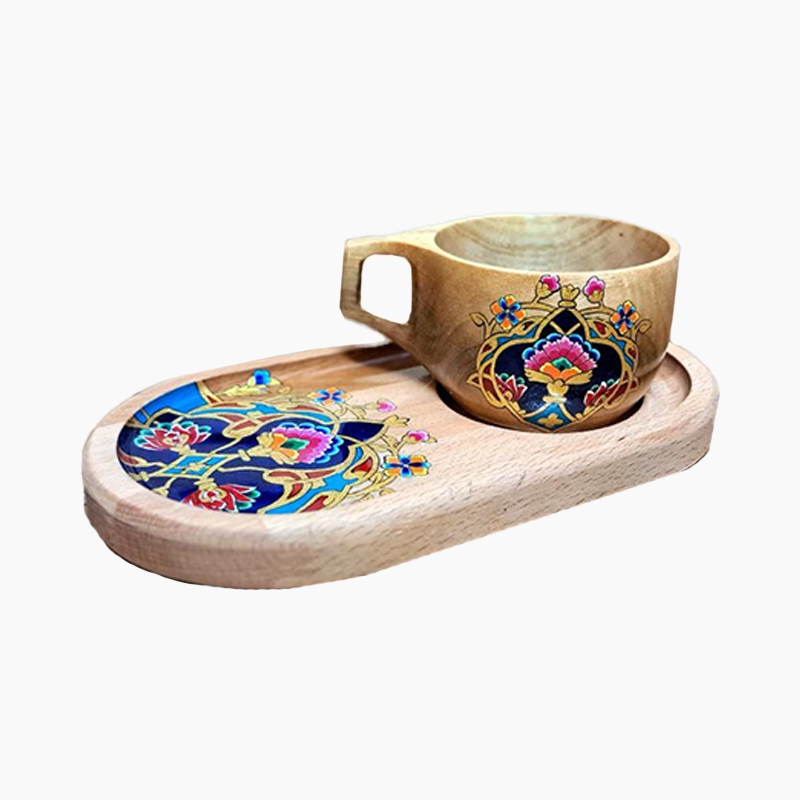Medieval Metalwork and the Persian Art of Enamel
Medieval metalwork refers to the art and craft of creating and decorating metal objects during the Middle Ages (roughly from the 5th to 15th centuries). This included the creation of:
- Religious vessels like chalices, crosses, and Gospel book covers
- Royal and religious jewelry such as crowns, medals, pins, and crucifixes
- Weapons and armor including swords, daggers, shields, and helmets
- Practical and decorative objects such as locks, lamps, trays, belts, and caskets
These items were typically decorated using techniques like engraving, enameling, repoussé, silver and gold inlay, and were crafted from metals such as iron, silver, gold, bronze, and copper. Medieval metalwork drew significant influence from Byzantine, Islamic, Celtic, and Gothic cultures, often featuring symbolic, religious, and narrative motifs.
Regional Styles of Medieval Metalwork
1. Western Europe (Christian Middle Ages)
Countries: France, Germany, England, Italy
Features: Rich use of gold and silver, religious vessels, enamelled church objects
Styles: Romanesque, Gothic
2. Byzantine Empire (Eastern Europe and modern-day Turkey)
Center: Constantinople (Istanbul)
Features: Lavish cloisonné enamels, religious iconography, elaborate goldwork
Influence: Heavily influenced Western European religious art
3. Islamic World (Middle East, Iran, North Africa, Spain)
Countries: Iran, Iraq, Syria, Egypt, Spain (Al-Andalus)
Features: Arabic calligraphy, geometric decoration, intricate metal engraving and cutwork
Note: Islamic metalwork was often more advanced than its Western counterpart
4. Scandinavia and Viking World
Countries: Norway, Sweden, Denmark
Features: Animal motifs, knotwork, burial items and jewelry
Overall, the most sophisticated examples of medieval metalwork can be found in Iran, the Byzantine Empire, and the Islamic world, although Christian Europe also produced highly symbolic and spiritual metal art.
Minakari: The Persian Enamel Art
Now, let us shift our focus to one of the most fascinating and colorful branches of metal art that emerged from the heart of Persia. In the following sections, we will explore the captivating world of Enamel — the Persian tradition of enameling — and its various forms and techniques.
According to the dictionary, Enamel or Persian enameling is defined as: “The painting and decoration of metals like gold, silver, and copper using special enamel colors that are fired and fixed under high heat.” The word “Mina” in Persian is a metaphor for the sky, which is why cobalt blue is the dominant color in many Minakari pieces, evoking the endless blue of the heavens.
When metals like copper, gold, silver—or even pottery—are coated with a white glaze and decorated with mineral colors, then fired in a kiln to stabilize the design, the result is Minakari. This is the simplest definition of this intricate art form.
Minakari on Copper
This is the most common form of Minakari and originates from Isfahan. It’s typically applied to decorative objects such as bowls, plates, candlesticks, and vases. Copper is ideal due to its high resistance to oxidation, durability, and affordability—making the final product both beautiful and cost-effective.
Enamel on Gold and Silver
Popular in southern Iran, particularly in cities like Ahvaz, this type is often used in jewelry. Because gold and silver resist oxidation much better than copper, the results are finer, more durable, and significantly more valuable.
Enamel on Pottery
Originally developed by Iranian artisans, this style has gained popularity in Lalejin and Hamedan. Enamel designs are applied to ceramic surfaces, then fired. These products are more affordable and easier to produce than their metal counterparts.
Types of Enamel(Minakari)
Minakari is not a single technique but rather a family of techniques, each with its own charm and complexity. Below, we explore the most recognized and practiced styles of Persian enameling:
1. Painted Enamel
Often referred to as Minakari of Isfahan, this style is the most recognizable and accessible. It’s mostly applied on copper and features hand-painted intricate patterns using mineral and organic pigments. Cobalt blue is especially prevalent.
2. Cloisonné Enamel
One of the oldest and most luxurious styles, this method—also popular in China and Russia—is a fusion of enameling and filigree. Fine metal wires are shaped into patterns, soldered onto the surface, and the enclosed spaces are filled with enamel before firing.
3. Embossed Enamel
Common on copper, this technique involves creating raised designs on the metal using traditional chasing methods, followed by the application of enamel. Popular in Isfahan, it adds a tactile dimension to Minakari art.
4. Jeweled Enamel
Highly valuable and primarily used in jewelry, this type integrates gemstones and crystals within enamel designs. A famous historical example is the shield of Nader Shah, now housed in Iran’s national treasury.
5. Enamel on Pottery
Popular in Lalejin, Hamedan, and Isfahan, this newer form mimics painted enamel but uses ceramic as its base. It’s more cost-effective and requires no metalworking skills, making it highly accessible.
6. Glass Enamel
Also known as vitreous painting or vitrail, this is a contemporary style applied to glass items. It’s especially popular in modern interior design, stained-glass windows, and decorative homeware.
Medieval metalwork, with its diverse regional styles and techniques, showcases the ingenuity and artistry of past civilizations. Among these, the Persian art of Minakari stands as a testament to the enduring beauty and craftsmanship of enamelwork. By understanding and appreciating these art forms, we not only honor the legacy of ancient artisans but also ensure the continuation of these traditions for future generations.
Note: This article is intended to provide an overview of medieval metalwork and the art of Enamel. For a more in-depth exploration, further research and consultation with specialized sources are recommended.

